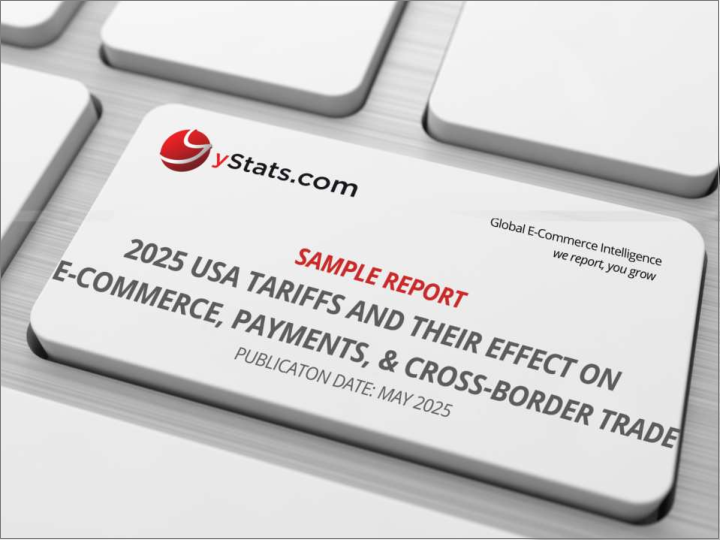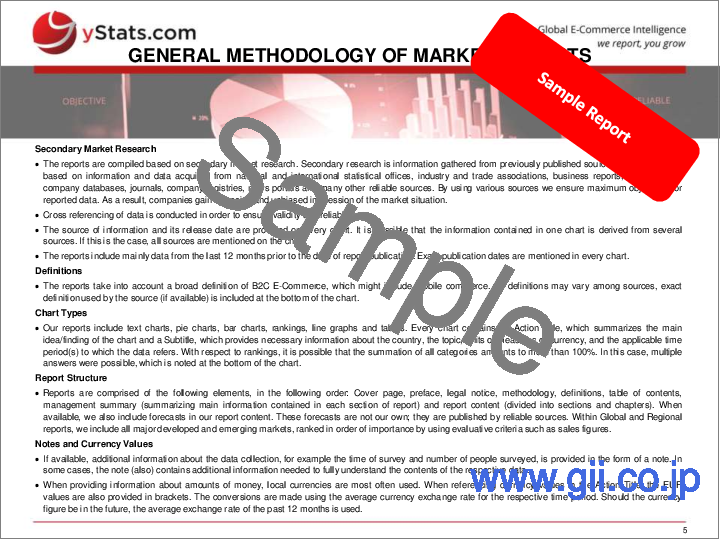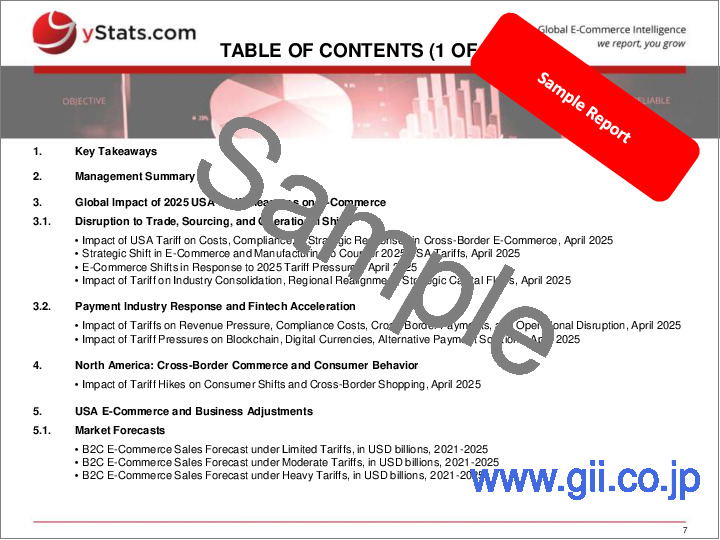|
|
市場調査レポート
商品コード
1725771
米国関税:eコマース、決済、越境貿易への影響 (2025年)2025 USA Tariffs and Their Effect on E-Commerce, Payments, and Cross-Border Trade |
||||||
|
|||||||
| 米国関税:eコマース、決済、越境貿易への影響 (2025年) |
|
出版日: 2025年05月14日
発行: yStats.com
ページ情報: 英文 40 Pages
納期: 即日から翌営業日
|
全表示
- 概要
- 目次
世界貿易への影響:関税がEコマースと製造業を混乱をもたらす
2025年の米国の関税政策は、世界のEコマースと製造業に大きな課題をもたらしており、運営コストとコンプライアンス対応の負担が増大しています。中国の越境EC業者は、物流コストの上昇に苦しんでおり、一部では荷物の誤表示などリスクの高い手段に頼るケースも出ています。米国の港湾では貨物取扱量が減少し、地域経済の安定性が脅かされています。
変化への適応:Eコマースの低関税地域へ移行
コスト上昇を抑えるため、多くのEコマース企業がベトナムやメキシコなどの低関税地域へ生産を移しています。同時に、価格設定、在庫管理、需要予測の効率化を図るため、AIへの投資も進んでいます。一方で、決済企業やフィンテック企業もコスト圧力の影響を受けており、収益性への懸念からビジネス戦略の再評価を迫られています。
消費者のシフト:米国消費者による中国のECプラットフォームの受け入れ
国内価格の上昇に伴い、米国の消費者は、米国で最もダウンロードされているショッピングアプリの上位5つに入る中国のTaobaoなどのプラットフォームをますます利用するようになっています。これに対応して、AmazonやSheinといった大手小売業者は調達や配送戦略を見直しており、Ankerのようなブランドは価格を引き上げています。関税の圧力があるにもかかわらず、米国のB2C Eコマースの売上は1兆3,000億米ドルに達する見込みで、企業はコストを抑制しながら顧客ロイヤルティの維持に努めています。
当レポートでは、米国関税のEコマース、決済、越境貿易への影響を調査し、関税圧力によるEコマース、フィンテック業界への影響、消費者行動への影響、関税シナリオによるB2C Eコマースの売上予測、ビジネス戦略とケーススタディなどをまとめています。
目次
第1章 重要ポイント
第2章 マネジメントサマリー
第3章 2025年の米国の関税措置がEコマースに及ぼす世界の影響
- 貿易、調達、業務の変化による混乱
- 米国関税が越境Eコマースのコスト、コンプライアンス、戦略的対応に与える影響
- 2025年の米国関税に対抗するためのEコマースと製造業の戦略的転換
- 2025年の関税圧力に対するEコマースの変化
- 関税が産業統合、地域再編、戦略的資本フローに与える影響
- 決済業界の対応とフィンテックの加速
- 収益圧力、コンプライアンスコスト、越境決済、業務中断への関税による影響
- 関税圧力がブロックチェーン、デジタル通貨、代替決済ソリューションに与える影響
第4章 北米:越境コマースと消費者行動
- 関税引き上げによる消費者動向と越境ショッピングへの影響
第5章 米国のEコマースと事業調整
- 市場予測
- B2C Eコマースの売上予測:限定的関税
- B2C Eコマースの売上予測:中程度の関税
- B2C Eコマースの売上予測:高い関税
- ビジネス戦略とサプライチェーンの変化
- Eコマース小売業者、関税圧力に対応しサプライチェーン運営を戦略的に転換
- Eコマースプラットフォームによる適応戦略とサプライチェーン革新の取り組み
- 関税の引き上げを受けたEコマースプラットフォームの運用体制の転換
- 関税引き上げにより、Eコマース企業はコンプライアンス強化と調達先の多様化を加速
- Amazonのケーススタディ
- 関税課題への戦略的適応
- 価格、小売、セクターの反応
- 関税によるEコマースの価格上昇と戦略転換
- 関税上昇による玩具価格と消費者需要への影響
- 投資と市場の信頼
- 関税の不確実性がM&Aおよび投資戦略に与える影響
第6章 中国の戦略的転換と国内の強化
- 米国の関税圧力を受け、Eコマースプラットフォームは戦略を転換
- 関税と国内Eコマースの変化への適応
第7章 総論
yStats.com Reveals How Tariff Tensions Are Reshaping Global E-Commerce in 2025 Through Strategic Shifts, Supply Chain Disruptions & Tech-Driven Adaptation
Global Trade Impact: Tariffs Disrupt E-Commerce and Manufacturing
The 2025 U.S. tariff policies have created significant challenges for global E-Commerce and manufacturing, increasing operational costs and compliance issues. Chinese cross-border sellers are struggling with rising logistics costs, leading some to resort to risky practices like mislabeling shipments. U.S. ports, are experiencing declining cargo volumes, threatening regional economic stability.
Adapting to Change: E-Commerce Moves to Lower-Tariff Regions
To mitigate rising costs, many E-Commerce businesses are shifting production to regions like Vietnam and Mexico, where tariffs are lower. At the same time, companies are investing in AI to enhance efficiencies in pricing, inventory, and demand forecasting. However, payment firms and fintech companies are also feeling the strain, as these cost pressures challenge their profitability and force a reevaluation of business strategies.
Consumer Shifts: U.S. Shoppers Embrace Chinese E-Commerce Platforms
As domestic prices rise, U.S. consumers are increasingly turning to Chinese platforms like Taobao, now among the top five most downloaded shopping apps in the U.S. In response, major retailers such as Amazon and Shein are adjusting their sourcing and fulfillment strategies, while brands like Anker are raising prices. Despite the tariff pressures, B2C E-Commerce sales in the U.S. are still expected to reach USD 1.3 trillion, with businesses working to maintain customer loyalty while controlling costs.
Table of Contents
1. Key Takeaways
2. Management Summary
3. Global Impact of 2025 USA Tariff Measures on E-Commerce
- 3.1. Disruption to Trade, Sourcing, and Operational Shifts
- Impact of USA Tariff on Costs, Compliance, & Strategic Responses in Cross-Border E-Commerce, April 2025
- Strategic Shift in E-Commerce and Manufacturing to Counter 2025 USA Tariffs, April 2025
- E-Commerce Shifts in Response to 2025 Tariff Pressures, April 2025
- Impact of Tariff on Industry Consolidation, Regional Realignment, Strategic Capital Flows, April 2025
- 3.2. Payment Industry Response and Fintech Acceleration
- Impact of Tariffs on Revenue Pressure, Compliance Costs, Cross-Border Payments, and Operational Disruption, April 2025
- Impact of Tariff Pressures on Blockchain, Digital Currencies, Alternative Payment Solutions, April 2025
4. North America: Cross-Border Commerce and Consumer Behavior
- Impact of Tariff Hikes on Consumer Shifts and Cross-Border Shopping, April 2025
5. USA E-Commerce and Business Adjustments
- 5.1. Market Forecasts
- B2C E-Commerce Sales Forecast under Limited Tariffs, in USD billions, 2021-2025
- B2C E-Commerce Sales Forecast under Moderate Tariffs, in USD billions, 2021-2025
- B2C E-Commerce Sales Forecast under Heavy Tariffs, in USD billions, 2021-2025
- 5.2. Business Strategy and Supply Chain Shifts
- E-Commerce Retailers Respond to Tariff Pressures with Strategic Shifts in Supply Chain Operations, April 2025
- E-Commerce Platforms' Strategies for Adaptation and Supply Chain Innovation, April 2025
- E-Commerce Platforms' Operational Shifts Amid Rising Tariffs, April 2025
- Tariff Hikes Push E-Commerce Firms to Strengthen Compliance and Diversify Sourcing, April 2025
- 5.3. Amazon Case Studies
- Amazon's Strategic Adaptations to Tariff Challenges, April 2025
- 5.4. Pricing, Retail, and Sector Response
- Price Hikes and Strategic Shifts in E-Commerce Due to Tariffs, May 2025
- Impact of Rising Tariffs on Toy Prices and Consumer Demand, May 2025
- 5.5. Investment and Market Confidence
- Impact of Tariff Uncertainty on M&A and Investment Strategies, May 2025
6. China's Strategic Pivot and Domestic Reinforcement
- E-Commerce Platforms Shift Strategies Amid USA Tariff Pressures
- Adapting to Tariffs and Domestic Shifts in E-Commerce, April 2025






